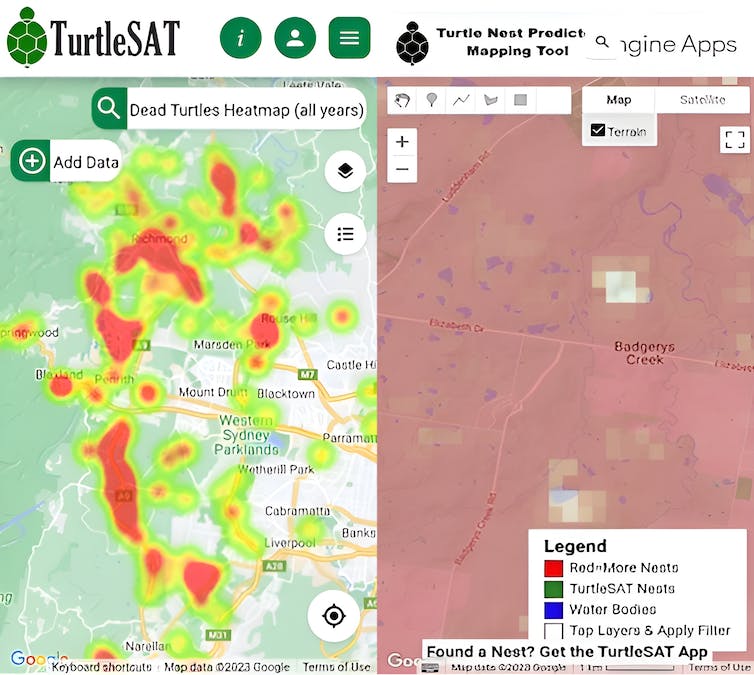Amid the controversy surrounding preliminary flight paths for Western Sydney’s new airport, another potential challenge is looming: turtles on the tarmac.
The land surrounding Sydney’s newest airport is prime nesting area for native turtles. This may create problems for the airport’s operations.
Turtle invasions at airports are not unprecedented. In recent years, a freshwater turtle was found wandering around Sydney Airport, which is built on Botany Bay. In 2021, a turtle strolling across a runway in Japan delayed five planes. A few years earlier, a passenger plane aborted takeoff because a 1.5m leatherback turtle was on the runway. And at John F. Kennedy International Airport in New York, employees carried 1,300 turtles off the tarmac in one nesting season alone.
Our expertise spans zoology, conservation biology and ecology. We know individual freshwater turtles can wander well beyond their wetland habitat into areas where they pose a risk to aviation safety, if proper planning is not in place. We urge authorities to incorporate turtle-friendly features into the airport’s design and make contingency plans for these remarkable reptiles.
Our turtle program shows citizen science isn’t just great for data, it makes science feel personal
Western Sydney airport is turtle nesting habitat
Freshwater turtles face an uncertain future. Their numbers in Australia are declining. Globally, more than half of all freshwater turtle species face extinction.
Collisions with vehicles are a main cause of death for adult freshwater turtles across south-eastern Australia. And data collected through the 1 Million Turtles citizen science tool TurtleSAT reveals Western Sydney is a roadkill hotspot.
Wetlands, including the area around the new airport at Badgerys Creek, serve as prime nesting habitat. Citizen science data also feeds into our world-first predictive nest mapping tool, which confirms Sydney’s newest airport is prime nesting area for both long- and short-neck turtles.
TurtleSAT and 1 Million Turtles
Turtles nest throughout the airport district from November to January. Given the number of wetlands and the extent of cleared, open vegetation, turtles can be expected to emerge from the water and traverse the entire area during this period.
Between nesting seasons, eastern long-necked turtles often move between wetlands on rainy days.
Redirecting turtles away from runways (and roads) is a challenging but feasible task. It requires proactive planning, integration of turtle-friendly design elements, and recognition of their significance in environmental impact assessments.
Construction of the Western Sydney airport involved filling in streams and farm dams. The Environmental Impact Statement for the project, released in 2016, recognised the threat to turtles. To mitigate the impact on aquatic animals generally, the proponents planned to salvage and relocate them to nearby habitats deemed suitable.
A spokesperson for Western Sydney airport, contacted for comment on this story, said all of the required wildlife and risk management procedures would be in place when the airport opens in late 2026. She said the turtle habitat was well outside of the airport site, so the risk of turtles on the runway was negligible.
But around the airport, many streams and wetlands remain. So we believe there’s still a chance turtles will enter the airport grounds and, potentially, walk onto runways.
Young cold-blooded animals are suffering the most as Earth heats up, research finds
Turtles at the crossroads
Turtles are often little more than an afterthought in hectic construction plans and timetables. Wetlands are often filled in and roads built without any thought to wildlife crossings.
Our study of the wetlands of Western Sydney, and the corridor between north-western and south-western Sydney, found up to 25% of wetlands were lost in the last decade alone.
Harriet Gabites, Author provided
While groups such as Turtle Rescue NSW can relocate wildlife such as turtles, eels and fish, many animals die when streams and wetlands are drained and filled during development.
Western Sydney’s new airport offers an opportunity to break this pattern. Construction has passed the half-way mark but it’s not too late to incorporate turtle-friendly infrastructure such as specialised underpasses and fencing to guide these slow-paced wanderers away from high-risk areas. We also need monitoring programs to check interventions are working and identify any problems along the way.
Our research emphasises education and awareness campaigns foster a culture of understanding and respect. This is important to ensure the long-term survival of turtles in the region.
TurtleSAT
It’s not too late for Western Sydney’s turtles
We must prioritise turtle-friendly design and integrate turtles into environmental impact assessments for major developments.
The likely presence of turtles on runways at Western Sydney’s new airport warrants immediate attention. The project and its network of major roads are a chance to demonstrate how major urban infrastructure and wildlife can coexist harmoniously.
We acknowledge the vital contribution of Western Sydney University masters student Harriet Gabites to research on the turtles of Western Sydney and this article.
Why Western Sydney is feeling the heat from climate change more than the rest of the city


